Reviews
Final Fantasy XIII-2
February 29, 2012, Author: Andy Corrigan
Call me crazy, but I’m in that bracket of Final Fantasy fans that absolutely loved the divisive iteration numbered XIII. Sure it was linear, but you know what? So are 80% of other, decent, JRPGs. Sure it took a while before it offered exploration, but guess what? Most JRPGs are linear by nature, especially in their approach to storytelling. Even the series’ golden child, FFVII, started slowly and took many, many hours (most of them climbing the stairs in the Shinra building) before it offered anything resembling the freedom that people assume comes part and parcel of the genre.
Still, I could see and recognise people’s complaints. It was, admittedly, slightly more restrictive than some JRPGs. It was missing the towns and cities that we all love to explore, where we would help charming townsfolk look for lost puppies and find the shops with the best equipment. I could see all those arguments, it’s just that those things didn’t matter to me compared to what the game did well.
I loved the setting, I loved the characters, I loved the strategy involved in the combat system, which many missed the point of. It became only the third Final Fantasy game that had taken me through to completion, and I loved every single second. It was the first Final Fantasy game since FFVII that I felt warranted an expansion on the universe and those characters, and my prayers were eventually answered.
So, while the announcement of Final Fantasy XIII-2 left many bewildered, thanks partly because FFX-2, the last direct sequel, sucked ass; and partly because people didn’t resonate with FFXIII as they’d hoped; I on the other hand, was relishing it.
So, it’s here in a relatively quick turnaround. Have Square Enix addressed the concerns of the majority?
Disclaimer: I haven’t yet completed Final Fantasy XIII-2, though I am on the final boss. I just haven’t found that winning strategy… yet…
Where we’re going, we don’t need roads…
Where most JRPGs start with lengthy cut-scenes and scene-setting, Final Fantasy XIII-2 plonks you straight into the thick of battle. At the very beginning you play as Lightning, who (for reasons unknown) is protecting a place called Valhalla from an attack lead by Caius; a mysterious antagonist whose motivations at this point are unclear. During the battle, a young man called Noel floats downwards from a portal in the sky. He’s a time-traveller, but knows not why he’s there or how he ended up in the middle of a battlefield. After helping Lightning, he agrees to find her sister, Serah, and bring her to Valhalla.
Noel leaves the way he came and travels to the world of New Bodhum on Pulse, where the former residents of Cocoon are trying make the best of life on their new world. Among their numbers is Serah, who is struggling to come to terms with the loss of both her fiancé, Snow (who has gone off on a mission), and her sister. The townsfolk are worried about Serah; she distinctly remembers Lightning surviving when Fang and Vanille sacrificed themselves to save Cocoon, yet no one else remembers and believes her sibling to be dead.
During a night where her dreams and nightmares about Lightning are particularly rampant, Serah awakes to find their small camp under attack. During the fight, Noel appears, saves her life and they help to push the onslaught back. Noel then provides Serah the hope that her sister is alive, and offers to help guide her there; however, the timeline that Noel uses to travel is fractured and rife with anomalies. They must travel through time and alternate realities to rectify paradoxes if they stand any hope of reuniting the two sisters.
From start to finish, I found this to be a thoroughly more enjoyable adventure than Final Fantasy XIII, and I liked that adventure. The story is told more clearly and concisely and benefits greatly from the quicker start. It also doesn’t linger too much on the events of the previous game, only referencing them; and while those events do have a part to play, they’re not the only part of a story that mostly goes its own way. I’d even go as far to say that newcomers to this universe could pick up FFXIII-2 and enjoy the story effortlessly.
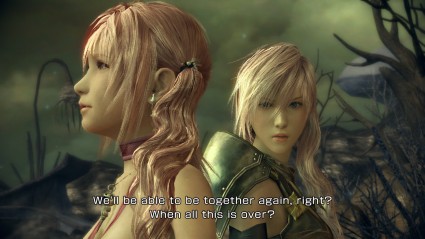
Sisters to the end.
While the events make more sense, the storyline is hurt slightly by the fact that you play almost exclusively as Noel and Serah, never adding new characters (in the traditional sense) to your party. With no group, there are not many opportunities for the duo to bounce off anyone but each other, no interesting dynamics other than this boy wanting to help the girl.
It helps less that, although both very likable and charming, neither of our pair are particularly strong or deep in character. Noel is a pure cookie-cutter JRPG protagonist and, despite the odd moment, never really grows beyond that. Serah is definitely more interesting with her endearing mix of naïvety and relentless optimism in spite of a sense of her fragility. Even then, she doesn’t come into her own until near the end. She does at least get there, though.
Caius on the other hand, is not only one of my favourite Final Fantasy villains for years, he’s one of my favourite characters full stop. He’s a multi-faceted villain, and although his actions seem vindictive and heartless, you can’t help but empathise with the man at various points; he’s a man in pain and lashing back at a world that keeps kicking him. Saying more than that will spoil things.
On the whole, Square Enix have crafted a story that feels a better fit for this setting and universe. A story that allows itself to be light in heart and charming at times, something that FFXIII can definitely be criticised for not doing enough. In doing that, it also manages to remain true to the tale that preceded it.
Honestly, it’s a plot that both fans and detractors of FFXIII can enjoy.
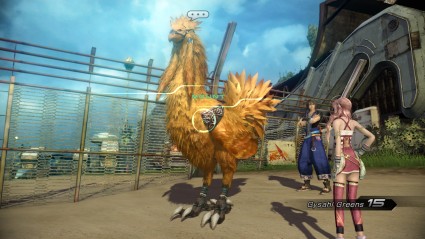
The chocobo has its place, as always!
Loosening the reigns
Almost straight off the bat, Final Fantasy XIII-2 offers more scope for exploration. The early parts of the game take place in the settlement of New Bodum and exploring the surrounding areas will yield winding paths, lots of different routes and loot to find in spherical floating chests. This sets the tone for the rest of the game; however, it offers a far more open-ended structure beyond that, thanks largely to its time travelling mechanic.
You navigate to the time and place you need to be using the Historia Crux, which is essentially a map of the time line. Each point in the map is a place and certain point in time, and each location will have a number of gates that allow you to other new areas in different time periods. It’s pretty freeing, as you can travel back and forth as you please, but you do have to unlock the time gates in a location by finding their corresponding artifacts before you can reach their destination.
As part of the adventure, you’ll eventually change history and fracture the timeline, and this will open paths for you to see the effects of what you’ve done by visiting the same location at different points in time, be it ten years or a hundred years.
It sounds a cheap tactic to reuse locations, but I can assure you that it’s not, and you’ll find yourself wanting to explore every avenue to see just what is different. You can also choose to ‘reset’ a time period, starting it afresh so you can go back in and do things slightly differently. This is entirely optional, but I found it a decent way to grind up a few levels.
It’s up to you how you manage your levelling, however; as another benefit to the open-ended setup up is that if you find yourself struggling at any point, you can leave that time period, go do something easier and then return when you’re a bit more powerful, taking the repetition out of levelling.
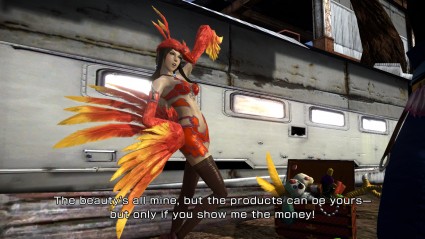
This is your arms dealer.
Also, much to the delight of Final Fantasy fans, there are loads of towns full of people to chat to and get side-missions from, and in this respect it feels more like a Final Fantasy game as a result. At times there are conversation trees, known as ‘Live Triggers’, which allow you to choose responses, not totally unlike certain Western RPGs on the market. There are still no shops in the traditional sense, but you’ll regularly encounter Chocolina; a time travelling sales person dressed like a Brazilian carnival dancer, and you can get lots of weapons and items from her as you progress.
There are also items to find that are trapped in time, affected by Caius’s rampage. They appear transparent, hard to spot from a distance and you can’t just open them as normal. Instead you’ll need to use your accompanying Moogle (which also acts as Serah’s weapon) to first fix the distortion with a tap of the right bumper. The Moogle also has other uses, as you can throw him a decent distance to reach chests that are out of reach by normal means.
The combat system from Final Fantasy XIII got a bit of a rough time back in 2010, and I think a lot of it was unwarranted. Unlike previous games, it wasn’t about the specific attacks you chose to help defeat enemies; the focus was on the setup of your team of three (only directly controlling one character) and how you used and changed their roles effectively in combat. It took foresight and strategy, and I loved it. The same system is here in FFXIII-2, only it’s faster-paced and slightly more action-packed.
Essentially, instead of levelling up a character based on their class, you level them up at individual roles using Combat Points (CP) in the Crystarium. The roles you can level are Commando, Synergist, Ravager, Sentinel, Medic, and Saboteur. You can then have any three of those in one group, and this is known as a paradigm. You can have six paradigms at any one time, and tailoring these to the foes you encounter is a must.
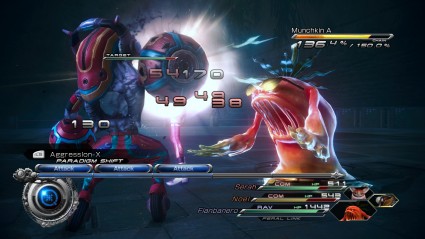
Just like Pokemon!
For example, you might need to weaken an enemy and buff your own party, so you might go for a Saboteur/Synergist/Medic to weaken, strengthen and keep yourself healed and then switch to a combo that is more offensively-minded once prepped. You may have times where you need to have your enemy focus on one party member, and that’s where the Sentinel comes in, acting as your tank, provoking while protecting themselves and freeing your other party members to wail on their target. Other times an enemy might have a high-powered attack that gets you all, and you can switch to a protective formation just before it hits.
The Stagger mechanic is still in effect too. Each time you attack an enemy, his stagger meter rises and then descends if you let up. If you can fill the bar, it will weaken them. Ravagers are well placed to stagger enemies but don’t do too much damage. Once you’ve staggered an enemy, you can switch to a formation with two or three Commandos to really get maximum damage while you have the chance.
It’s a really sweet combat system that requires thought, and boss fights especially are a test of your mental mettle.
There is a slight twist on this, though. You only have two traditional party members in Noel and Serah; the third spot is taken up by a monster that you’ve collected by beating them in battle. Sounds a bit like another game, doesn’t it?
While Noel and Serah can learn multiple roles, the monsters can only have one, although they do all have their own skill trees that you can upgrade with items won in battle. Plus, you can also dress them up with cute accessories… Win!
Newly added in to some fights here are Cinematic Actions. Yup, Quick-time events. I shuddered when I first heard this was a feature, but they’re well enough implemented to make you feel a part of what’s going on. Plus, successfully completing them will give you a nice CP boost.
Just like in the last game, losing a battle will simply give you the option to retry and plonk you back into the world just before the fight, leaving you fully healed and giving you a chance to escape if you so wish. With this, each downed character comes back fully healed too, so you’re not idly wasting your items. While I enjoy the harsher, older games, I really liked this, helping the game flow a lot better, which can be an issue in a genre that often requires repetitive grinding.
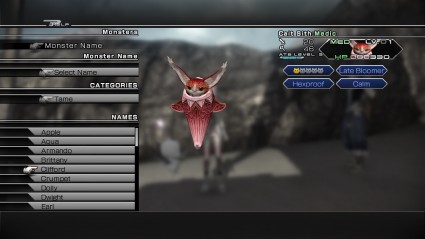
You can put a hat on a cat!
Feast for the eyes…
Just like Final Fantasy XIII, this follow-up is absolutely gorgeous, but sometimes not quite as gorgeous. XIII was full of lush, high-definition cut-scenes, but here most of the cut-scenes are done in-engine to both save disk space and offer the quick-time sections mentioned above. Don’t let that put you off, they still look awesome, but you can just tell they were all produced in the game engine.
The game also looks beautiful in general gameplay, with character models and designs that other JRPG developers haven’t been able to match this generation. Although the design of enemies and characters pretty much follow the guidelines set out by its predecessor, their design is charming, while the various locations give off a feeling of peaceful innocence, making the threats befalling them feel all the more harsher. Not only that, all the locations feel alive and real. Seriously, I’ve never seen a futuristic city as beautiful as Academia in the future.
Is this a chill-out album?
The weirdest part of Final Fantasy XIII-2 is that the music doesn’t, for most part, doesn’t resemble anything from a Final Fantasy game, acting more as a chill-out album than a game soundtrack. Most of the backing tracks to general gameplay feature soft vocals, light Drum & Bass beats and airy pads, and I must admit that I found the vocals overlaying it all a tad jarring. Oddly, though, the more I played, the more the style grew on me. It makes sense too; to me JRPGs have always been games to sit back and relax to, and this fits in with that mentality.
Of course, the game is still capable of those big orchestral numbers as it ramps up the tempo when in battle. Metal tracks rage over certain boss fights, while upbeat techno beats cover others.
The composition and placement of all the tracks is amazing too. When visiting an under-attack Academia for the first time, the sad, almost Noir music highlights a sadness and hopelessness in a situation where most other developers would have went for something more generically upbeat. Well done Square Enix, for daring to be different.
PS. The Choboco song is ten bells of pure awesome.
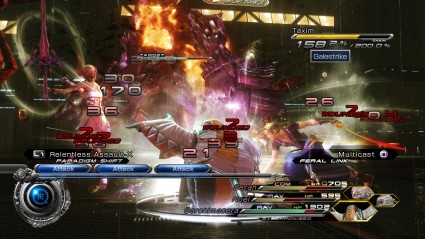
Boss fights are fantastic.
May your Fantasy never be Final…
Square Enix have really outdone themselves here, and in such a short time-frame too. They’ve taken what did work well from the previous game and then padded those elements with all the exploration, distractions and charm that a lot of fans sorely missed from FFXIII.
While that’s resulted in a shorter game, it feels a more expansive and complete game, and one that has an infinitely improved structure and lots of charm. Fans of JRPGs will adore it.
The people spoke and Square Enix answered. You can’t say fairer than that.
Platforms: PS3, Xbox 360 | Tagged Caius, Etro, Final Fantasy, Final Fantasy XIII, Final Fantasy XIII-2, Lightning, Motomu Toriyama, Noel, Pokemon, Sazh, Serah, Snow, Tetsuya Nomura, Valhalla, Yeul, Yoshinori Kitase



